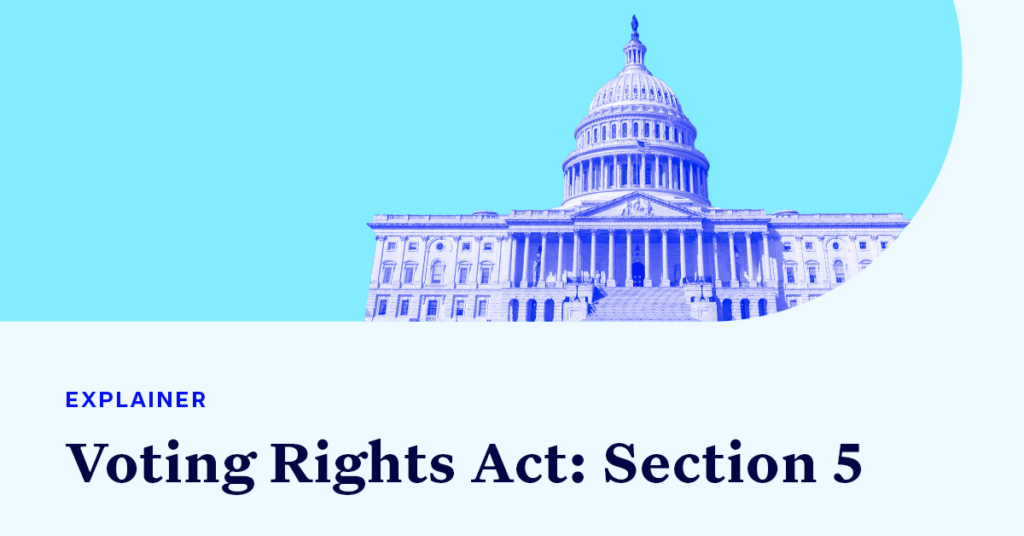The Heart of the Voting Rights Act

The Voting Rights Act (VRA) is a historic and powerful tool that has allowed the federal government to rein in discriminatory voting laws across the states. Prior to the VRA’s passage, state and local lawmakers had spent decades disenfranchising Black voters. While every state could do more to improve and expand access to the ballot, at the time of the VRA’s passage in 1965 Congress determined that certain states — especially in the South — would be subject to federal oversight in passing election laws due to their history of voter suppression.
What is Section 5 of the Voting Rights Act?
This federal enforcement derived its strength from Section 5, which mandated that certain “covered” jurisdictions with a history of discriminatory election laws must get federal pre-approval before any newly proposed voting legislation could go into effect. In short, Section 5 allowed the federal government to block state-sponsored discrimination before it occurred, targeting those jurisdictions most likely to continually disenfranchise voters.
Section 4 of the VRA established a formula, comprised of two key calculations, for determining whether a state would be subject to Section 5’s pre-approval provisions. If a jurisdiction both mandated any kind of “test or device” that might restrict its eligible voting population and had fewer than 50% of its voting-age population registered to vote at the time of the 1972 general election, it became subject to Section 5 preclearance. Examples of restrictive tests included literacy tests, “moral character” assessments and requirements that someone else vouch for a voter’s qualifications — all well-known methods used to disproportionately disadvantage Black and minority voters. The formula also banned states from providing election materials solely in English if 5% or more voting-age citizens are from a “single language minority.”
Pursuant to this formula, nine states were subject to Section 5 preclearance in their entirety: Alabama, Alaska, Arizona, Georgia, Louisiana, Mississippi, South Carolina, Texas and Virginia. Individual counties or townships in California, Florida, Michigan, New York, North Carolina and South Dakota were also covered. Section 5 of the VRA was thus a powerful piece of legislation reaching across 15 states — a majority of which were in the South.
The impact of Section 5 was swift and significant — and made frightfully clear the enduring damage of Jim Crow’s legacy in the South. Between 1970 and 2000, the U.S. Department of Justice brought nearly 1,000 objections to proposed voting changes in covered jurisdictions. Federal observers dispersed in the tens of thousands to oversee the fair and free administration of elections in historically suppressive states. And, until recently, the U.S. Supreme Court upheld the constitutionality of Sections 4 and 5 in multiple cases after the VRA’s passage.
Where does Section 5 stand today?
In 2013, five conservative judges struck down Section 4’s coverage formula in the Supreme Court case Shelby County v. Holder, making Section 5 essentially unenforceable. The Court concluded that since the data used to determine which jurisdictions were subject to preclearance was from 1975, the formula had “no logical relationship to the present day” and was an unconstitutional infringement on states’ rights.
The Shelby County majority opinion also asserted that the decades since the VRA’s passage witnessed a significant expansion in voting rights and, consequently, that many of the problems originally prompting the legislation had been resolved. In her dissenting opinion, joined by Justices Stephen Breyer, Sonia Sotomayor and Elena Kagan, Justice Ruth Bader Ginsburg argued that it was thanks to the enforcement power of the VRA itself that such improved access to the vote could be seen across the Section 5 jurisdictions. “Throwing out preclearance when it has worked and is continuing to work to stop discriminatory changes is like throwing away your umbrella in a rainstorm because you are not getting wet,” Ginsburg wrote.
Since Shelby County, states previously subject to preclearance have enacted countless restrictive voting laws that disenfranchise Black voters. Additionally, for the first time in over 50 years, redistricting laws in states previously subject to oversight no longer need federal approval. The Shelby County decision cut the teeth out of the VRA, rendering the provisions of Section 5 largely ineffective until Congress can pass a new coverage formula — as Democrats are striving to do right now with the John Lewis Voting Rights Advancement Act, which would update the existing formula with current data and add a host of other requirements states must fulfill to avoid preclearance.
What’s next?
Passing the John Lewis Voting Rights Advancement Act is the next major battle for voting rights in this country. Section 5 of the VRA was a powerful and effective tool to protect the voting rights of Black Americans, and it is vital that Congress strengthen and expand it in the face of unprecedented attacks on our elections, our election officials and access to the ballot box.